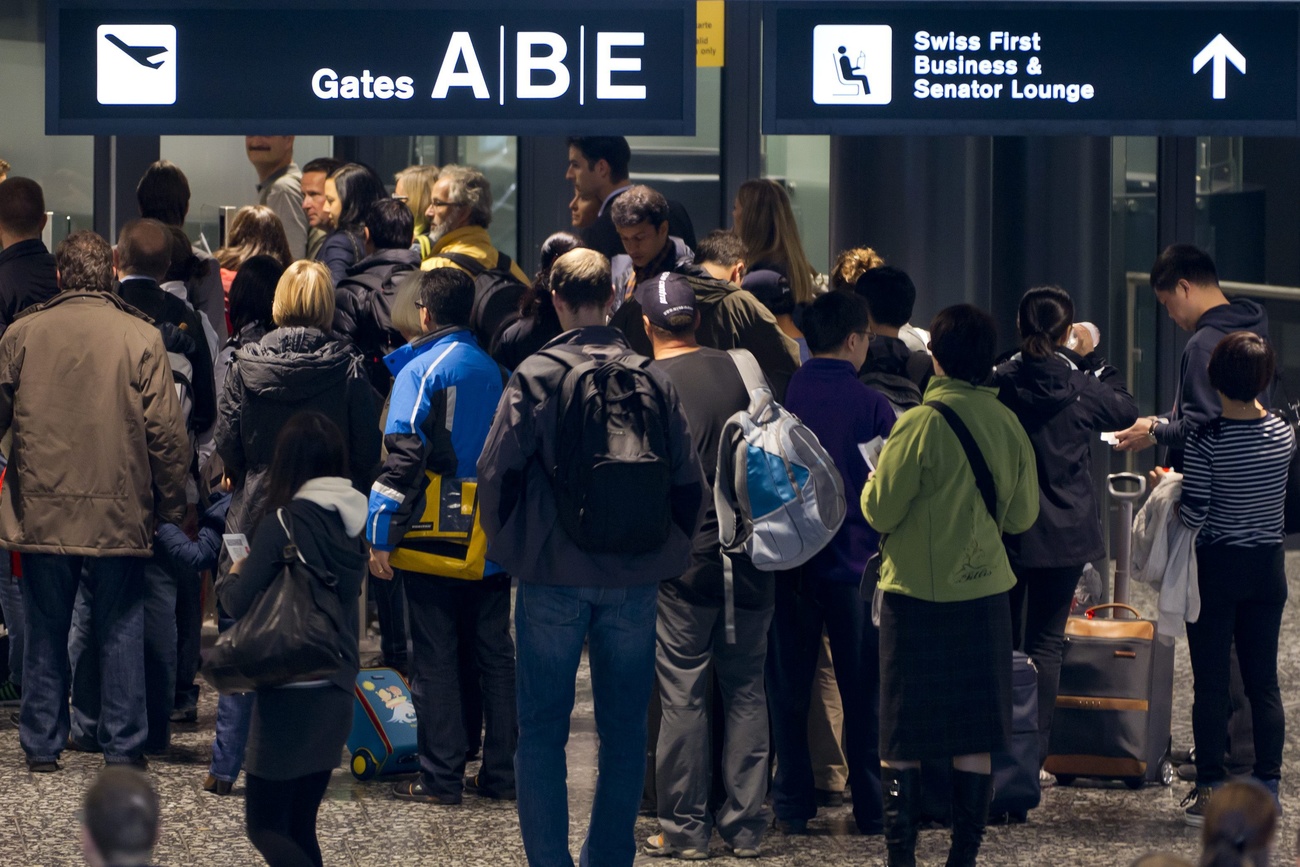
In Switzerland, migration isn’t just inbound

The high immigration figures for Switzerland make it easy to forget that not everyone who arrives is going to stay. In fact, the Alpine country has a comparatively high ratio of emigrants to immigrants. Who are the 90,000 or so foreigners who leave Switzerland each year, and why do they do so? New data obtained by SWI swissinfo.ch helps shed light on this outbound movement.
This article is part of our “In Data” series devoted to immigration, a hot issue in Switzerland like in most developed countries. An analysis of the figures can help provide a clearer understanding of the issue and deconstruct certain preconceived ideas. In other articles, we shall be looking at the structure of immigration in Switzerland and the question of asylum.
Switzerland is, without doubt, a land of immigration. In the ten-year period from 2013 to 2022, net foreign migrationExternal link (the difference between the number of people coming to live in the country and those leaving to live elsewhere) averaged 66,000 people a year, thereby contributing 85% to population growth.
In 2023, the inclusion in these statisticsExternal link of more than 50,000 Ukrainian refugees drove the migration balance to historic levels: +148,000 foreign nationals – largely accounting for the record demographic growthExternal link observed that year. Net migration again sank to around 95,000 in 2024, according to provisional figuresExternal link.
This sustained immigration is reflected in the diversity of the Alpine country’s population, 30% of which are first-generation immigrants – Switzerland is among the countries where this proportion is highest. Overall, 40% of permanent residents have a migration backgroundExternal link.
This inevitably gives rise to a range of societal issues. While the country’s leading political force, the Swiss People’s Party, is particularly vocal in its fight against “uncontrolled immigration”, the question of migration is, as in other countries, a source of tension beyond the ranks of the sovereigntist right-wing party.
>> Read this article to gain a better understanding of the issues surrounding immigration in the context of an ageing demographic and labour shortages:

More
How countries are managing immigration between economic needs and social tensions
Tens of thousands of emigrants each year
All this helps to mask another reality. Tens of thousands of foreigners also leave Swiss territory every year, whether by choice or by need.
“There is a tendency to forget that immigrants don’t necessarily settle down,” says sociologist Liliana AzevedoExternal link, associate researcher at the Swiss research centre on migration, the NCCR – on the moveExternal link, and the Portuguese Emigration ObservatoryExternal link in Lisbon.
Between 2013 and 2022, an average of 155,000 foreign nationalsExternal link arrived in Switzerland each year. At the same time, around 90,000 people left; in other words, for every 100 immigrants there were around 60 emigrants. Since the early 2000s, the emigration rate has climbed more moderately, but more steadily, than the immigration rate. In 2024, over 95,000 people left the country, a slight increase over the previous year.
Swiss nationality is generally inherited by descent (jus sanguinis) and is notoriously difficult to obtain. It is therefore common for people who were born in the country, or who have lived there most of their lives, still to be legally foreigners and to be considered as immigrants (usually with a C permit) in the statistics.
Thus, some of the foreign emigrants mentioned in this article are people who do not have Swiss nationality but for whom emigration is not necessarily synonymous with return migration; they regard Switzerland as their home and are likely to come back. C permit holders may leave Swiss territory for six months without notifying the authorities; they may request an extension of this period for up to four years. .
Return migration above the European average
Like in other European countries, the rate of return migrationExternal link has fallen in Switzerland since the war in Ukraine. This is mainly due to the high number of refugees from this country who are unable to go home. In 2023, the rate of return was 40 emigrants for every 100 immigrants. In 2024, it rose to 50 per 100.
But whether one takes the figures for 2021, 2022 or 2023 (the latest year for which European data is available), Switzerland is among the countries with the highest number of immigrant departures. The following graph gives the average for the three-year period.
Most emigrants leave five years after arriving
The return migration rate alone allows for only limited analysis, as the people who immigrate to Switzerland are not necessarily the same as those who leave.
The Swiss Federal Statistical Office (FSO) also provides longitudinal data, which give more insight into people’s migratory movements. These statistics follow a cohort of individuals who arrived in the country in the same year, shedding light on their migration trajectoriesExternal link and changes in statusExternal link.
They show that, as in other countries, the departure rate of immigrants is higher in the first few years following their arrival. Of the 200,000 foreign nationals who arrived in Switzerland in 2011 (all statuses combined), half had already left the country five years later and nearly 60% had done so after 11 years. Most departures occurred in the first two years.
The FSO also provided SWI swissinfo.ch with statistics on all foreign nationals who immigrated to Switzerland between 2014 and 2023. These totalled 1.85 million people over the ten-year period, including the most recent arrivals – in particular refugees from Ukraine. By the end of 2023, 800,000 people had left; that is, more than 40% of the total.
When foreign-born immigrants are asked how long they plan to spend in Switzerland, most nonetheless say they intend to stay for good. In 2021, nearly two-thirdsExternal link said they wanted to stay for the rest of their lives, and 9% for at least five years. A small minority planned to leave earlier, while one quarter were undecided.
So, what is the reason behind these disparities? Each decision to migrate is unique and depends on many factors, but some possible explanations can be put forward.
Few long-term residence permits granted
The type of residence permit obtained is a major factor in determining how long people stay. Most immigrants to Switzerland obtain a B residence permitExternal link or an L short-term residence permitExternal link. The L permit, valid for a maximum stay of one year, is the most precarious. Nearly one third of people who immigrated in 2011 received an L permit. Over 70% of them subsequently left the country.
Meanwhile, over 50% of those who immigrated that year obtained a B permit, which is the most common type and has to be renewed every year. Nearly half of them also left the country.
Of all the people with a residence permit who arrived in 2011, only a minority had consolidated their right to stay in the country 11 years later: 30% had received a C settlement permitExternal link – an open-ended authorisation generally issued automatically after 10 years of residence or five years of uninterrupted residence; and 4% had been naturalised.
‘Work is what ties people to Switzerland’

The granting of a residence permit, and its type, are often conditional on employment. ‘Work is what ties people to Switzerland’, Azevedo notes.
Along with family reasons, work is cited as a major impetusExternal link for migration, whether to or from Switzerland. An increasing number of people also say they plan to leave the country once they retire, possibly on economic grounds.
Success or failure on the job market are thus key factors in determining whether migrants stay or leave. The situation is particularly difficult for people who do not speak one of the main national languages, or whose qualifications are not recognised.
“Unemployment and insecure or low-skilled jobs are all obstacles to staying for more than a few years,” says Azevedo.
>> A number of people who have immigrated to Switzerland have told us about their experiences, some very positive, some very difficult, in our discussion forum below:
More
Many people also come to Switzerland for a one-off professional or academic experience but form little attachment to the country and easily move away to pursue their careers elsewhere. The free movement of people within Europe since 2002 has not only boosted immigration to Switzerland, but also encouraged a more international approach to work. Today, “career paths are increasingly marked by multiple moves and changes”, Azevedo notes.
>> This article on Swiss-EU economic relations focuses on the issue of freedom of movement:

More
Swiss-EU economic relations in eight charts
Portuguese most likely to go home
The statistics show that different groups of foreign nationals tend to stay different lengths of time in Switzerland. A long-term studyExternal link of immigrants who arrived in Switzerland in 1998, conducted by the NCCR – on the move, found that 23 years on an extremely high proportion (over 80%) of people from developed countries outside Europe (in particular Japan and the United States) had left the country. At the other end of the spectrum, immigrants from the former Yugoslavia and Sri Lanka, who generally arrived in the context of family reunification, had for the most part stayed.
The departure rate of EU citizens (primarily German, Portuguese, Italian and French nationals) has accelerated since the introduction of freedom of movement. They now make up the majority of both emigrants and immigrants.
The highest rate of return migration, meanwhile, is to be found among the Portuguese, with 83 emigrants for every 100 immigrants in 2023. In that year, net migration of Portuguese nationals returned to slightly positive growth, after six consecutive years in which emigrants outnumbered immigrants.
Statistics extracted specially by the FSO at the request of SWI swissinfo.ch confirm that most emigrants were returning to their home country: in 2023, three quarters of German, French, and Italian nationals who left Switzerland were heading to their country of origin (the country of which they were nationals). This proportion was even higher among the Portuguese: almost 87% of those emigrating went to Portugal.
Age is also a factor here. People who emigrate on retirement are more likely to return to their country of origin, whereas younger people are more mobile between different countries.
Meanwhile, Portuguese nationals tend to emigrate at a later age than others. Almost 60% of Portuguese who left Switzerland did so after the age of 40 – and more than one quarter after the age of 60. In comparison, most people of other nationalities who left Switzerland did so between the ages of 20 and 40.
Yearning for home
The “ideology of returning home” is still very prevalent within the Portuguese community, according to a 2023 studyExternal link by the University of Neuchâtel. Compared to other groups of foreigners studied, the Portuguese have the strongest ties to their homeland and are least likely to feel that they belong in Switzerland.
Across all nationalities, homesickness was cited as a decisive factor for leaving in 7% of casesExternal link.
The image of the low-skilled workers of the second half of the 20th century, emigrating in droves with the goal of working and saving money in order to return home, with no intention of settling down, has long been associated with the PortuguesExternal linke. While there is certainly truth in this, it can also be linked to the seasonal residence permit, which is all they were eligible for, and which would not have allowed them to settle in any case.
Today, Portuguese immigration is much more multifarious, especially since the economic crisis that hit Portugal in the early 2010s. Soaring unemployment rates sparked a new wave of immigration. Although better qualified than earlier generations of immigrants, some found it difficult to find jobs that matched their skills.
This also led many to feel they were just passing through and to dream of returning to their roots.
Now, as the specialist in Portuguese migration Azevedo points out, both the socio-economic situation and the image of Portugal have changed. The Portuguese government has even made the return of its citizens part of its political programmeExternal link. “Many of those who emigrated because they had to headed home as soon as they could.”
Adapted from French by Julia Bassam/ds

More
Our weekly newsletter on geopolitics

In compliance with the JTI standards
More: SWI swissinfo.ch certified by the Journalism Trust Initiative

















![The four-metre-long painting "Sonntag der Bergbauern" [Sunday of the Mountain Farmers, 1923-24/26] had to be removed by a crane from the German Chancellery in Berlin for the exhibition in Bern.](https://www.swissinfo.ch/content/wp-content/uploads/sites/13/2025/12/01_Pressebild_KirchnerxKirchner.jpg?ver=a45b19f3)












You can find an overview of ongoing debates with our journalists here . Please join us!
If you want to start a conversation about a topic raised in this article or want to report factual errors, email us at english@swissinfo.ch.